Attempting to understand and comply with the regulation as set forth in the Canada Labour Code Part 2 and Canadian Occupational Health and Safety Regulation Part XI can be tricky for federally regulated Canadian businesses, all of whom genuinely care about and lose sleep over keeping their workers safe. Often when we try to comprehend the issues, we end up with more questions than answers; especially when we attempt to interpret broad definitions. Such has been the case with vertical enclosed spaces such as monopoles and water tower shafts most commonly occupied in the realm of the telecommunications industry.
In an effort to determine whether such structure types do, in fact, fall under the definition of a confined space, we analyzed the rules and standards set by COHSR and CSA, as well as reached out directly to ESDC Labour Program for additional clarification on the matter.
Confined Spaces Defined:
COHS Part XI defines a confined space to be an enclosed or partially enclosed space that:
- Is not designed for human occupancy
- Has a restricted means of access and egress
- May become hazardous to any person entering it owing to its:
- design, construction, location, or atmosphere
- the materials or substances in it
- any other conditions relating to its design


Popular wisdom falsely continues to base confined space identification on an existing atmospheric hazard. This is not the case. The rule stipulates that the mere potential of an atmospheric hazard need exist. Furthermore, an atmospheric problem such as oxygen deficiency can be induced simply through human occupancy of said space. This being said, we believe a monopole fits the criteria of a confined space under current law.
It should be further noted that even if no atmospheric hazard exists either potentially or in reality, the rule further stipulates that confined space identification is not limited to atmospheric hazards but can and does identify issues with access/egress, internal configuration and /or other identified hazards such fall hazards, power issues, lighting, etc.
CSA Z1006-16:
The Canadian Standards Association (CSA) has a different, yet similar definition of a confined space for the purposes of their Management of Work in Confined Space standard. CSA Z1006-16 defines a confined space as any workspace that:
- Is fully or partially enclosed
- Is not designed or intended for continuous human occupancy
- has limited or restricted access or egress, or an internal configuration that can complicate first aid, evacuation, rescue, or other emergency response services.

Entry Permit System
Once a space has been determined to fit the definition of a confined space, the employer must appoint a qualified person to conduct a risk assessment, which is designed to identify all of the potential hazards to the space, and report on those hazards.
Once the hazards have been identified, the qualified person must create an entry permit system which is to be designed in order to grant entry to the space. An entry permit system must include procedures for entering the confined space, the period of time that one is able to occupy the space, the hazards applicable to the space and how to reduce or eliminate them, and a rescue plan in the event rescue is needed. It`s also important that the entry permit system include all of the equipment necessary to carry out the work, in addition to safety and protective equipment.
Monopole telecommunications tower: Enclosed Space
While it seems clear based on the definitions of confined spaces set forth in COHS Part XI and CSA, it`s not. Generally, employers fail to recognize or consider a monopole or similar vertical structure to be a confined space, and therefore, do not take all necessary precautions.

Let`s assume for a moment that you`re conducting some work inside a 40 metre monopole structure, along with “John”, your co-worker who is working above you at roughly 35 metres. Suddenly, you notice that John is no longer responding to you, and has fallen unconscious. You have no idea what caused this, but know you need to do something. Would you go and attempt to revive or rescue him?
If you answered yes to this question, then you are noble, however, you may not be aware of the statistics that over half of the deaths reported in accidents involving confined spaces are actually the would-be rescuer(s) who are going in after the initial victim(s). This could be into sewer systems, grain silos, vaults, digestors, and yes, monopole structures.

In order to safely extract John from within the tower, you should first attempt to confirm what caused john to lose consciousness and that the conditions are safe (oxygen levels are sufficient, there are no potential chemical asphyxiants, or any other hazards that you suspect to be present).
There are countless potential hazards that you need to consider, understand, and if possible, remove. However, in order to do so one needs to incorporate a system that includes the entry and rescue procedures, all necessary equipment, and ensure that anyone accessing the space is trained on the procedures and the equipment.
The Opinion of Labour Canada
As a result of the fact that the definition of a confined space under COHSR is vague in regards to monopoles, we reached out directly to a representative from the ESDC Labour Program for clarification. We included the following photos of a standard monopole:




After reviewing the photos, we received the following response:
In view of the photos of the monopole that you submitted to me, I am of the opinion that this is indeed a confined space. The size of the opening is restricted and it is not at ground level. The interior space of the monopole is quite small on the first picture, as in a bottleneck. This indoor space is not designed to perform normal everyday work, such as a workshop, garage, office or warehouse.
They also indicated that in light of the fact that a standard monopole does meet the definition of a confined space, that an employer whose employees are accessing such spaces must do the following:
- Conduct the Hazard Assessment as outlined above
- Establish a Permit Entry System (PES) for those accessing the space
- Specify the safety equipment and tools to be used in the space
- Appoint a qualified person to test the space prior to entry (i.e. 4 gas detector, oxygen detector, etc. ) and ensure that the conditions can be maintained throughout occupancy
- Provide protective equipment, including oxygen monitors and ventilation equipment
- Provide appropriate training on the safe use of the equipment above, as well as best practices for entering the confined space
- Keep records of all persons accessing the space, as well as any hazards encountered throughout occupancy of the space

It is important to note that while the subject of this article relates to monopoles generally, we believe that any other space with similar characteristics as a monopole (i.e. water tower shafts, or other similar spaces) represent similar risks, and should therefore require similar procedures for ensuring safe work in the space, in addition to rescue procedures and essential training.
If you wish to determine whether a space that your employees will occupy is defined as a confined space, CSA has included an exhaustive list of examples that can be found in CSA Z1006-16 in Annex A.2. Additionally, a useful tool for health and safety advisors/committees in determining best practices for the specific confined spaces that their specific organization will be dealing with is the flow chart Figure 1 of the CSA Z1006-16 Annex. We haven`t included these annexes here for copyright purposes. CSA Z1006-16 is available for purchase on the CSA website store at the link below:
Conclusions:
Given the countless potential risks and hazards of working inside monopoles and other similar structures, we agree with the ESDC – Labour Program that they do fit the definition of a confined space under the regulation and law. Given this fact, companies working in such spaces must follow the steps provided in the previous section of this article in order to reduce or eliminate the risk of injury or death to their workers when entering and working within confined spaces, and be compliant with the Canadian Occupational Health and Safety Regulations – Part XI.
For inquiries into how this may impact your business, for consultation services, or help training your employees, we can help. You can reach us through the following link:

